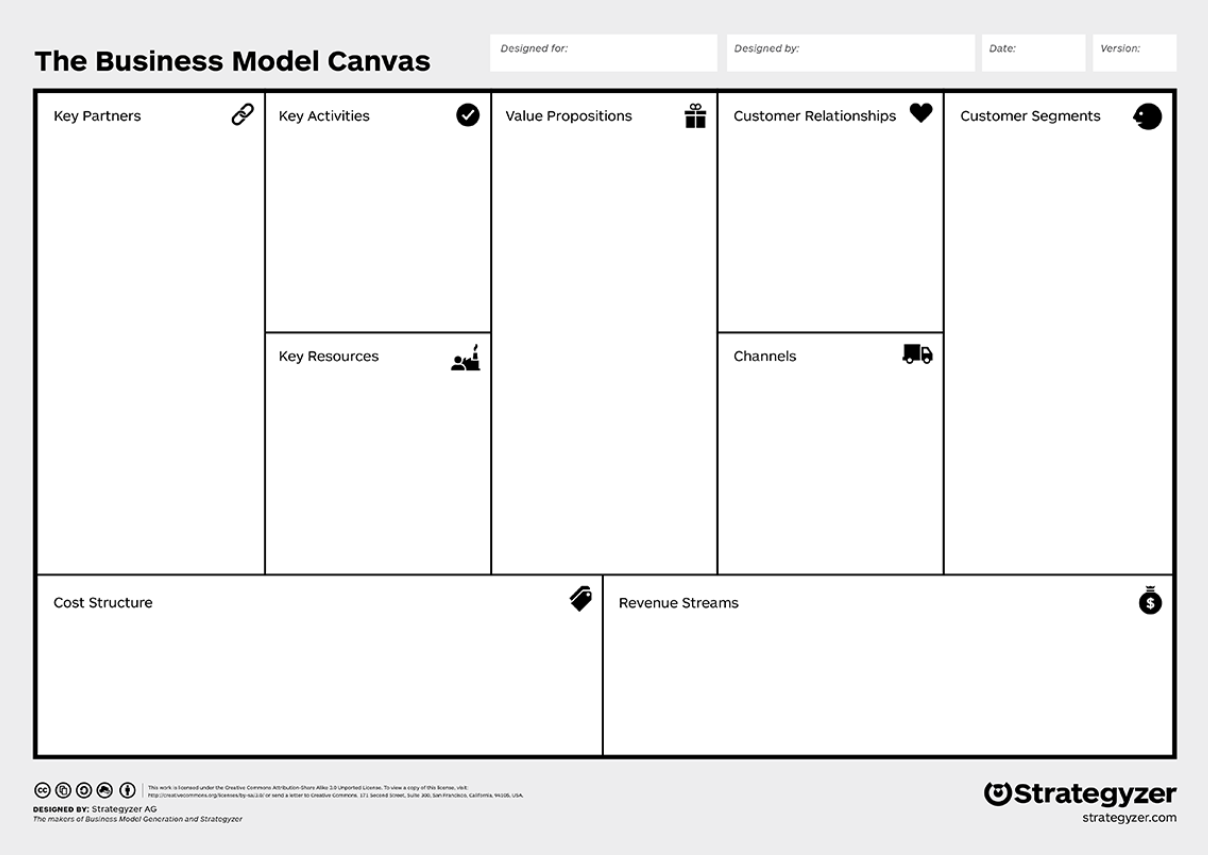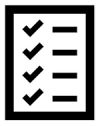Learning Objectives
- Describe the term “business model”
- Understand the role the Business Model Canvas in the LEAN startup method
- Explain and understand each component of the business model canvas
- Populate the business model canvas with your chosen startup idea
We often hear the term “business model” used in discussions on startups, but what exactly does this term mean? A business model describes how a business delivers value to its customers, how it collects value back from those customers, and how it accomplishes this in a competitive manner. This description is often made through some sort of diagram or plan. This plan considers how the business structures its relationships, manages its resources, and connects with customers. It separates each aspect of the business into its separate components to allow us to understand them on an individual basis, but also outlines how each component works together to deliver and collect value. Have a look at the video below to get you started on how we start to move from simply an idea to a business model while implementing the LEAN startup approach.
Remember that we also mentioned that it helps to be able to visualize the business model. This is often because a business model is quite an abstract concept, especially for businesses that have not yet started! To help us visualize the busines model and all its components, several tools have been developed by practitioners and academics. For this course, we will focus on the Business Model Canvas (BMC). The next video briefly describes this tool.
As you saw from the video above, the Business Model Canvas (BMC) consists of nine elements: customer segments, value proposition, channels, customer relationships, revenue streams, key activities, key resources, key activities, and key partnerships. It is designed to place them in a logical order to help with the visualization.

The BMC is designed to explain a business model quickly and easily. This lets us make significant changes to our business models as we learn about our customers and modify our ideas. Remember, a startup is an organization searching for a business model, so change is going to happen!! If we had to describe our business model in a traditional business plan using text, it would take quite a bit of writing. It would make each change to our model slower and less likely to happen, since we would have to rewrite everything – not fun! The BMC requires very little writing, so making changes takes very little time! Below is a more detailed video on the BMC in its entirety. We will then delve into each of the nine components, and provide a brief example through our example of an ATV tour provider.
The Business Model Canvas work is licensed under the Creative Commons Attribution-Share Alike 3.0 Unported License
Customer Segments are the different groups of people that the business wishes to reach and serve. Simply put, without customers a business will not survive. Startups must make careful decisions about how to group customers into segments, and which of these segments to serve.
For an ATV tour provider, we can choose to serve adventurous tourists to a particular region, or we may also target local organizations looking for a corporate retreat activity. We will consider customer segments in more detail in Section 2 of this course, however the next video provides an overview.
Value Propositions describe the bundle of products and services that the startup offers, but also describes the value it delivers to the customer segments. It also addresses what problems it helps customers solve, or the needs that the business meets for its customers.
For a local ATV tour, the value proposition involves the tour itself, but also accomplishes the job of giving customers a unique and local experience in Newfoundland through a fun an enjoyable means of transportation. It also creates memories for travelers and develops teamwork for our corporate retreat clients.
Channels are the means to which a business communicates with the customer segments before, during, and after a purchase, and how it delivers value to customers. Generally speaking, channels can be virtual or physical. Virtual channels include online channels, and physical channels would be something like a brick-and-mortar store.
The channels for an ATV tour operator would likely be through a website, where customers can make bookings. The service is then delivered through a physical channel on site, and the business can also maintain contact with customers after the tour through social media and email.
Customer relationships describe the ways in which a startup gets, keeps, and grows its customers. These tactics are closely connected to the business’ channels. A business must decide how it will bring customers to their channels and have them perform a desired action – such as a purchase, signing up for a free trial etc. This component also considers tactics to keep the customers satisfied so that they return. Finally, it includes how a business tries to increase a customer’s purchase amount and how those customers can spread word about your business through word of mouth.
We must consider both virtual channels and physical channels for the ATV tours. We could use the Newfoundland tourism site and Facebook ads to bring customers to our website. Once arrived, we will get them to book a tour by offering special offers for first-time clients. We will also make sure that we post professional and prominent signage in key stops and destinations in the area so that visitors can find us.
Revenue Streams
Revenue streams is the value we collect from customers – which is usually cash. We can often consider both revenue strategies and pricing strategies in this section. Revenue strategies include how customers are charged such as the sale of an asset, subscriptions fees etc. pricing strategies discuss the price of a product or service and whether pricing is fixed or dynamic.
Note that we use the term “value” as something we collect from customers. While this value is most often cash, value can be other things. For example, if you are a customer of YouTube, you don’t pay to watch the videos. However, your attention and use of YouTube is valuable for the company because they can sell the advertisements that you see to other companies by having you as a viewer on the platform.
Our ATV tour example will charge a fee for service, that is, a fee for each type of tour. The price will be dynamic to account for changes in seasonal and weekly demand.
Key Resources
Every business needs resources in order to survive and to be able to create their products and services, and deliver value to customers. This component outlines the main resources that a business requires. These fall under the broad categories of physical, intellectual, human, and financial resources. For example, a patent or brand would be intellectual property, while physical assets might include inventory for a store. Through our ATV example, key resources would be ATVs themselves, marketing material, and human resources for tour guides.
Key Activities
Key activities are the actions that a business must complete in order to create its products or services, and deliver them to the customer. These are usually phrased as action words. For our example of the ATV tours, key activities may be managing client bookings, performing the tours themselves, and reaching new audiences.
Key Partnerships
Businesses will not likely have all resources required to execute their business models, and likely should not perform all activities themselves. For these reasons, businesses for key partnerships so that they partnering organizations can provide resources or perform certain activities. Key partnerships can include key suppliers, or strategic alliances for marketing, cooperating with competitors (like other tour guides in a similar area).
Cost Structure
The cost structure indicates the costs that stem from our key resources, key activities and our key partnerships. We will cover cost structure in more detail later in the course. For now, let us consider our cost structure in terms of fixed costs and variables costs. Fixed costs remain the same regardless of how much product or service is sold, whereas variable costs increase with the more product or service sold. If, for example, we rented an office for our tour business’ main office, the rent would be a fixed cost. Fuel and maintenance on the ATVs would be variable costs.
That was quite a bit of work, however the better you understand these concepts, the easier and more likely you will be able to come up with new and innovative business models to remain competitive.

- Now it is time to try populating a business model canvas for your own startup idea! Remember, this is a first step and the model will change over time. However, we need to start somewhere!
- It is up to you whether you’d like to create a business model canvas as a hard copy or digital version. You can download the business model canvas here. We recommend using colored Post-it notes to fill in the information.
- If you would like to complete a digital version, we recommend using a tool called Stormboard. This free tool has the BMC as a built-in template so that you may populate it with digital colored Post-it notes. You can include up to 5 people on a Stormboard in the free version of the product.
- After you have filled out the BMC, feel free to send it to the Navigate Program Manager for feedback. Keep the canvas on-hand because you will be making changes to it as you get feedback from customers in section 3 of the course.
Congratulations on completing section 1 of the course! So far you should have a good startup idea of yourself/yourselves, your own means, and your own network. With that knowledge, you conducted an ideation session to help find a problem that you would like to solve and/or a business that you feel would be both interesting and viable. You should also be familiar with the broad LEAN startup method that we will follow to test the idea and iterate based on what we learn. Finally, to help visualize and make sense of these iterations, we learned about business models and the Business Model Canvas. You should now have first iteration of a business model – we’re rolling! In Section 2, we will look more closely at the Value Propositions and Customer Segments and estimate the size of the market for your business ideas.

